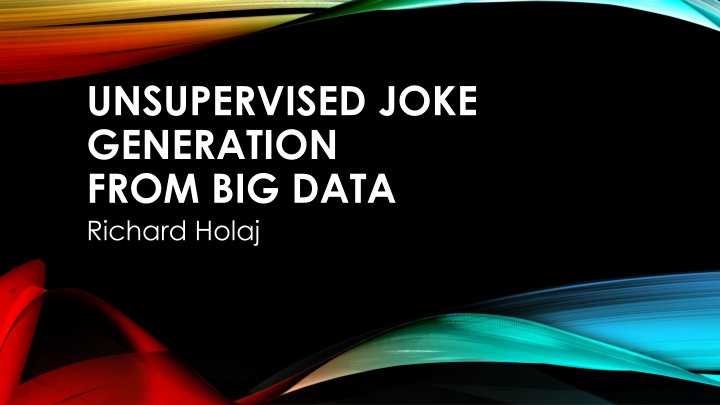
Unsupervised Joke Generation from Big Data Research Insights
Explore the challenges and solutions in unsupervised joke generation from big data, including humor generating techniques, model factors, automatic evaluation results, and human evaluation feedback. Discover insights from the study conducted by Petrović and Matthews in 2013.
Download Presentation

Please find below an Image/Link to download the presentation.
The content on the website is provided AS IS for your information and personal use only. It may not be sold, licensed, or shared on other websites without obtaining consent from the author. If you encounter any issues during the download, it is possible that the publisher has removed the file from their server.
You are allowed to download the files provided on this website for personal or commercial use, subject to the condition that they are used lawfully. All files are the property of their respective owners.
The content on the website is provided AS IS for your information and personal use only. It may not be sold, licensed, or shared on other websites without obtaining consent from the author.
E N D
Presentation Transcript
UNSUPERVISED JOKE GENERATION FROM BIG DATA Richard Holaj
HUMOR GENERATING INTRODUCTION very hard problem deep semantic understanding cultural contextual clues solutions using labelling
TASK DESCRIPTION reduced to I like my X like I like my Y, Z. , jokes X, Y nouns, Z - adjective simple syntax generation, but difficult word filling unsupervised
MODEL JOKE IS FUNNIER WHEN: 1. Z is used to describe both nouns - f of co-occurence 2. Z is less common -1/f(Z) 3. Z is ambiguous - number of Z meanings (approx.) 4. X and Y are not similar - 1/sim(X, Y) DATA - Google 2-grams data (tagged with POS tags)
AUTOMATIC EVALUATION LOL - likelihood (just containing Xs - LOcal Log) ROFL (Rank OF Likelihood) rank of human jokes 48 randomly sampled jokes from Twitter Model Baseline (1) Baseline + 4 Baseline + 2 Baseline + 3 Baseline + 2 + 3 (Model 1) All factors LOL-likelihood ROFL 0.1909 0.2431 0.1467 0.1625 0.1002 0.1267 -225.3 -227.1 -204.9 -224.6 -198.6 -203.7
HUMAN EVALUATION 5 native English speakers 3-point scale (1 funny, 2 kind of funny, 3 not funny) BL, Models 1 + 2, 32 jokes from Twitter (no overlap) Model Randolphs s kappa Mean % funny jokes Human jokes Baseline Model 1 Model 2 0.31 0.58 0.52 0.58 2.09 2.78 2.71 2.56 33.1 3.7 6.3 16.3
EXAMPLE I like my relationships like I like my source, open.
SOURCE Petrovi , S.; Matthews, D.: Unsupervised joke generation from big data. In Proceedings of the 51st Annual Meeting of the Association for Computational Linguistics (Volume 2: Short Papers), Sofia, Bulgaria: Association for Computational Linguistics, August 2013, s. 228 232. Dostupn z: http://www.aclweb.org/anthology/P13-2041
